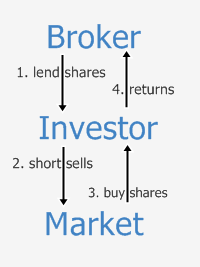Great start you've completed part 1 of 3
Short-selling is when an investor predicts that the price of an asset, such as stocks, commodities or currencies, is going to fall, and agrees to sell that asset in the relevant market at a certain price - without having actually purchased the asset.
In order to complete this transaction the asset is borrowed from a third party, normally a broker. The broker will require the short-seller to create a margin account into which they must deposit a minimum proportion (margin) of the value of the trade.

Let's take a look at a detailed example...
A fund manager decides that shares in Apple are overpriced and predicts they will fall. In order to benefit from this the fund manager decides to short-sell 1,000 Apple shares at their current price of $500. The total value of this transaction is $500,000.
The trade details are: Trade Date: 1/2/2012 Settle Date: 4/2/2012 Sell Short 1,000 Apple shares @ price of $500 per share. Total amount: $500,000 (1,000 * $500). For the sake of simplicity we'll leave out any fees.
A month later the fund manager decides to close out this position. This is done by buying Apple stock on the market and returning it to the broker that it was borrowed from in the short-sell trade, this is known as a Buy-to-cover trade. Below is an overview of the two trades:
Sell-short: The fund manager borrows 1,000 Apple shares from his broker and sells them on the market
Buy-to-cover: To close out this position the fund manager now buys 1,000 shares at the current market price and returns them to the broker that the original short-sell was placed with.
Let's look at the possible outcomes if the Apple share price a) falls below or b) rises above $500 when the Buy-to-cover trade is made and whether it means the fund makes a realized gain or loss on the trade.
a) On 1/3/2012 the price of Apple shares is $450 and the fund manager closes out the position by placing a Buy-to-cover trade of 1,000 Apple shares. Below are the trade details:
Trade Date: 1/3/2012 Settle Date: 4/3/2012 Buy-to-cover 1,000 Apple shares @ price of $450 per share. Total amount: $450,000 (1,000 *$450)
The fund realizes as profit the $50,000 difference between the price at which it sold the shares it borrowed and the lower price at which it was able to purchase the shares it returned.
b) On 1/3/2012 the price of Apple shares is $580 and the fund manager closes out the position by placing a Buy-to-cover trade of 1,000 Apple shares. Below are the trade details:
Trade Date: 1/3/2012 Settle Date: 4/3/2012 Buy-to-cover 1,000 Apple shares @ price of $580 per share. Total amount: $580,000 (1,000 *$580)
This time however the fund realizes a loss of $80,000, which is the difference between the price at which it sold the shares it borrowed from the broker and the higher price at which it had to purchase the shares it returned.
Starting to make some sense? Short-selling can be confusing at first but the principles are fairly simple once explained properly. If you've further questions feel free to email us.
What's the most famous short-sell trade?
In 1992, George Soros, one of the founders of the first hedge funds, "shorted" sterling by risking $10 billion that the value of the currency would fall. Soros eventually made a reported $1 billion from the deal, and was said to have "broken the Bank of England" when, as a result of his trades, the bank was forced to devalue the currency and withdraw it from the European Exchange Rate Mechanism.
Why would a fund manager short-sell?
Speculation: Fund managers use short-selling to gain exposure to risk. When a fund manager short-sells he is betting on the price falling and is rewarded if this has happens. Speculating differs from hedging because speculators deliberately assume risk, whereas hedgers seek to mitigate or reduce it.
Hedging: Unlike George Soros above the majority of investors use short positions to hedge. This means they are protecting other long positions with offsetting short positions.
Good work, now test what you've learned below! Completed part 2 of 3
Well done. You've finished this lesson. Check out more lessons here
Subscribe to free lessons. Sign me up!